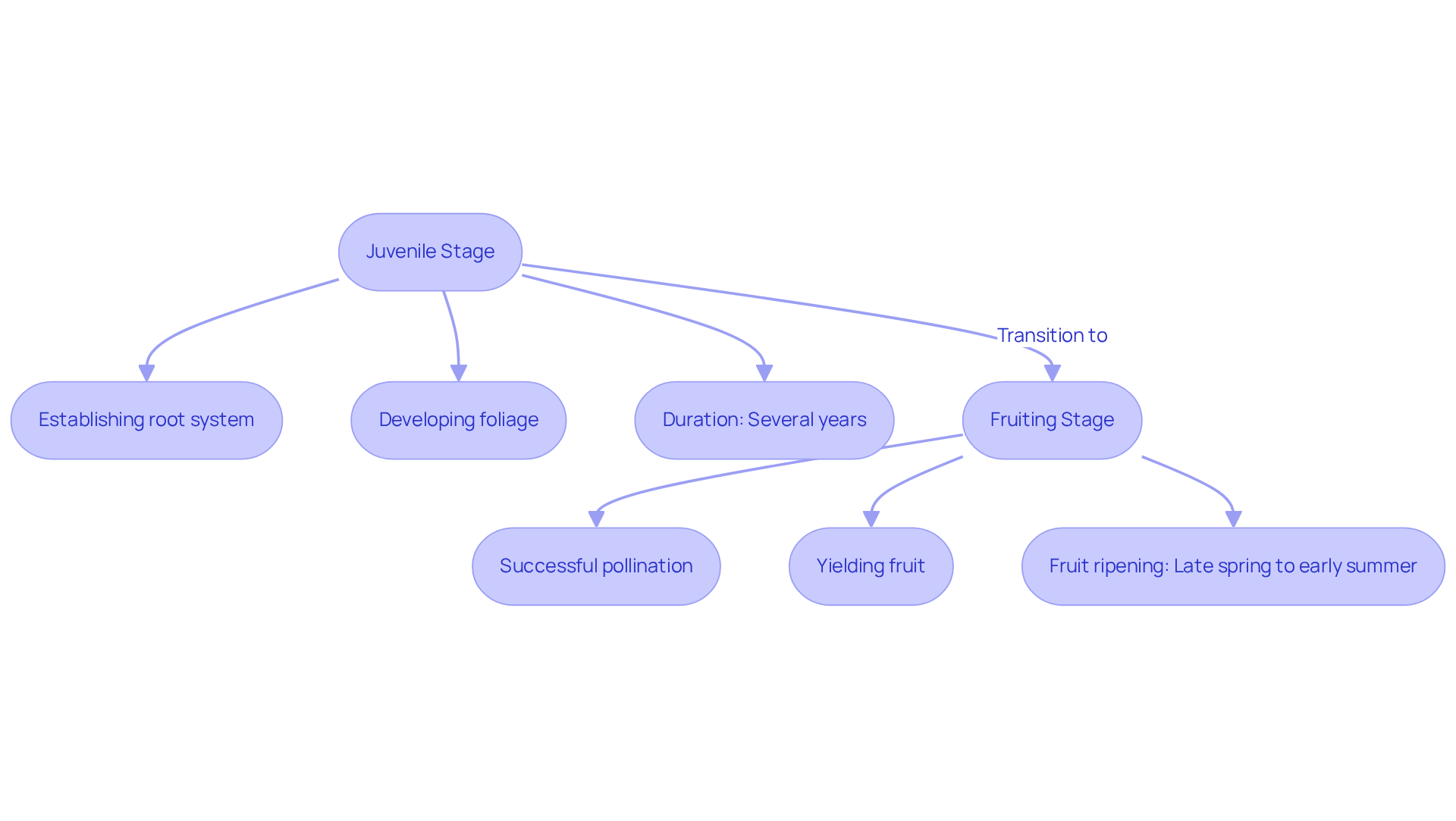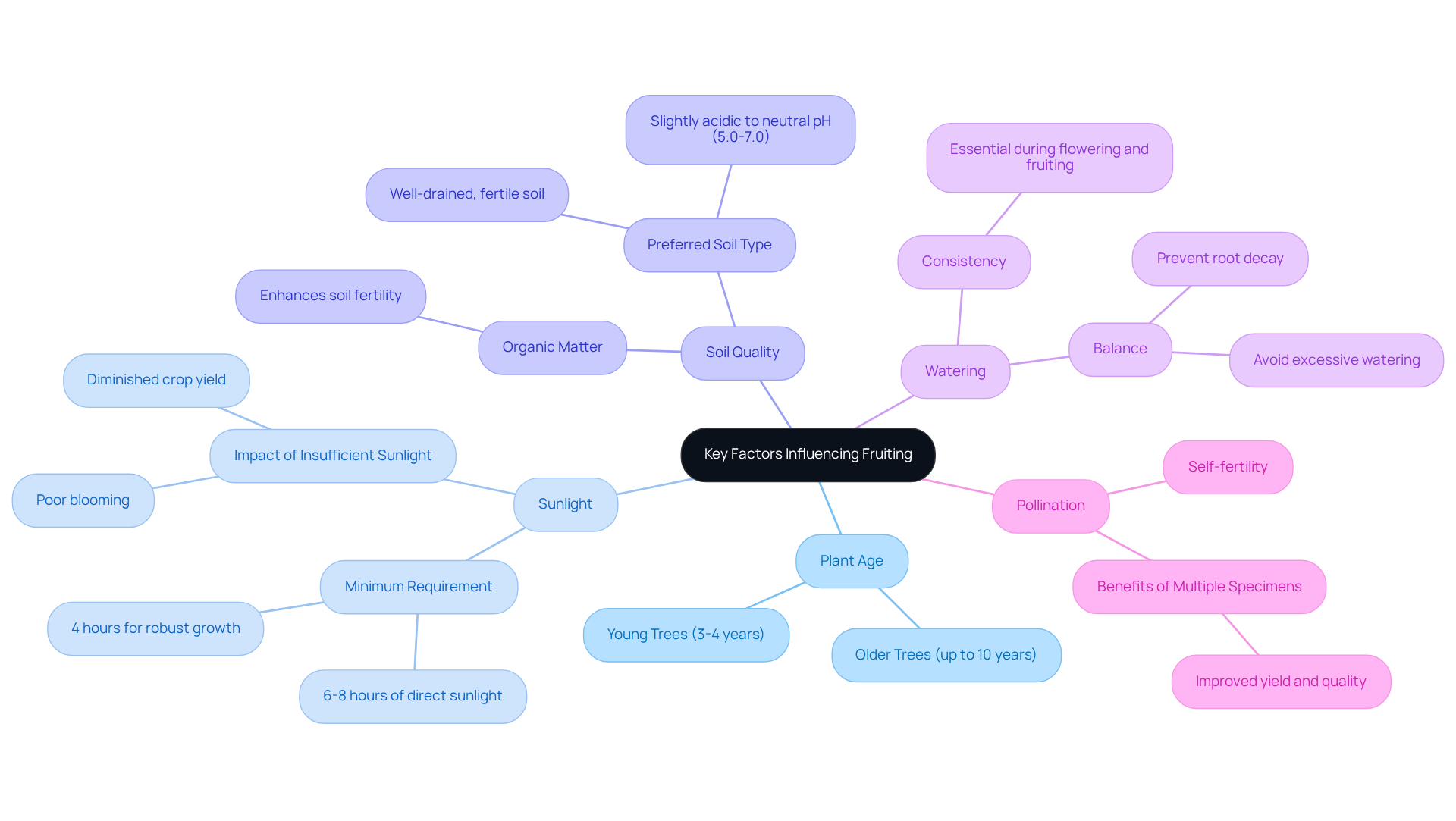Understanding the intricate growth stages of mulberry trees is essential for any gardener eager to reap the rewards of their labor. These trees can take anywhere from a couple of seasons to nearly a decade to produce fruit, depending on the variety and care they receive.
As the quest for fresh, home-grown berries unfolds, it is crucial to consider the factors influencing when mulberries will bear fruit. By delving into the essential elements of sunlight, soil quality, and proper care techniques, gardeners can unlock the secrets to a fruitful harvest and enjoy the sweet rewards of their efforts.
Thinking about growing a Mulberry Tree in your garden?
Explore Mulberry trees collection at Everglades Farm - shipped directly from Florida.
1. Understand Mulberry Tree Growth Stages
Mulberry plants progress through distinct growth phases, leading to the important question of when do mulberries produce fruit. Typically, plants grown from seed may take between 5 to 10 seasons to bear fruit, while grafted varieties from Everglades Farm's Fast-Growing Trees collection can start producing in as little as 1 to 2 seasons. This rapid production makes them an excellent choice for home gardeners seeking quick results. The growth stages include:
-
Juvenile Stage: In this initial phase, the plant concentrates on establishing a robust root system and developing foliage. This stage can last several years prior to any flowering. Upon reaching maturity, the plant enters the flowering stage, which raises the question of when do mulberries produce fruit, a crucial time for the development of fruit. Successful blooming is vital for subsequent fruit development. Notably, these fruit-bearing plants require approximately 400 chill hours to trigger blooming, an essential aspect of their growth cycle.
-
Fruiting Stage: After successful pollination, the tree begins to yield fruit, prompting the question of when do mulberries produce fruit. The berries generally ripen from late spring to early summer, influenced by the specific variety and local climate conditions.
Understanding these stages allows gardeners to provide suitable care at each phase, promoting healthy growth and ensuring fruitful yields. As noted by horticulturists, grafted fruit trees can bypass the juvenile stage, enabling them to bloom and produce fruit within their first or second growing season, making them a rewarding option for enthusiastic gardeners. Furthermore, White Mulberries exhibit the fastest growth at 5 feet per year, while Black Mulberries grow at a rate of 1 to 2 feet per year. Explore Everglades Farm's diverse offerings, including professional-grade fertilizers, to enhance your home gardening experience.

2. Identify Key Factors Influencing Fruiting
Several key factors influence when and how well mulberry trees produce fruit:
-
Plant Age: Younger plants may require more time to produce. Typically, plants start to produce crops at about 3 to 4 years old, but when do mulberries produce fruit? Certain types may require as long as 10 years if cultivated from seed.
-
Sunlight: Mulberry plants flourish in full sun, needing a minimum of 6 to 8 hours of direct sunlight each day. Inadequate sunlight can result in poor blooming and diminished crop yield. Research indicates that plants in shaded regions might yield fewer produce and display slower growth rates, highlighting the significance of sufficient light exposure. Furthermore, mulberry plants need a minimum of 4 hours of direct sunlight daily for robust growth and fruit production.
-
Soil Quality: Well-drained, fertile soil is crucial for healthy growth. Mulberries prefer slightly acidic to neutral pH levels (5.0 to 7.0) and benefit from regular additions of organic matter, which can enhance soil fertility and support crop production.
-
Watering: Consistent moisture is essential, especially during the flowering and fruiting stages. However, excessive watering can result in root decay, so keeping a balance is crucial for ensuring healthy plants and optimal produce quality.
-
Pollination: While numerous species of fruit-bearing plants are self-fertile, having multiple specimens can enhance pollination, leading to improved fruit yield and quality. This is especially advantageous for types that display dioecious traits, where male and female flowers grow on different plants.
Furthermore, it is essential to trim nearby plants or bushes that may block sunlight, ensuring that the fruit-bearing plants receive sufficient light exposure. By understanding these factors, gardeners can create an environment favorable for produce production, maximizing their enjoyment of berries throughout the growing season.

3. Implement Care Techniques for Optimal Fruiting
To ensure optimal fruiting of mulberry trees, implement the following care techniques:
-
Fertilization: Begin with a balanced fertilizer in early spring as new growth emerges. A 10-10-10 NPK fertilizer is recommended. An additional application after fruit set can further enhance yields, promoting healthier and more abundant fruit production.
-
Watering: Water deeply and consistently, particularly during dry periods. Newly planted saplings require more frequent watering until they are established, while mature specimens will need less, ensuring the plants remain hydrated and vibrant.
-
Pruning: Carry out pruning in the dormant season (late winter) to remove dead or diseased branches and shape the plant. Effective pruning promotes better air circulation and sunlight penetration, both crucial for understanding when do mulberries produce fruit, leading to a more fruitful harvest.
-
Pest Management: Keep an eye out for common pests like mealybugs and aphids. Employ organic pest control methods, such as insecticidal soap or neem oil, to manage infestations while protecting beneficial insects, thereby maintaining a healthy garden ecosystem.
-
Mulching: Apply a layer of organic mulch around the base of the plant to retain moisture, suppress weeds, and enhance soil quality as it decomposes, creating a more favorable environment for growth.
By following these care techniques, gardeners can significantly enhance the fruiting abilities of their berry plants, allowing them to understand when do mulberries produce fruit, ensuring a bountiful and healthy harvest.

4. Troubleshoot Common Fruiting Issues
If your mulberry tree is not producing fruit, consider these troubleshooting tips:
-
Insufficient Sunlight: Mulberry plants flourish in full sun, requiring a minimum of 6 hours of direct sunlight each day. If your plant is shaded by other vegetation or structures, consider relocating it or trimming nearby foliage to enhance exposure.
-
Poor Soil Conditions: Conduct a soil test to assess pH and nutrient levels. Mulberries prefer a slightly acidic to neutral pH, thriving in pH levels that range from neutral to mildly acidic. If the soil is compacted or nutrient-deficient, amend it with organic matter or compost to improve fertility and drainage, promoting healthier growth.
-
Water Stress: Both overwatering and underwatering can stress the plant, leading to poor fruiting. Ensure the soil remains consistently moist but not soggy, soaking it at least 2 feet deep to reach the root system. Adjust your watering schedule based on weather conditions, aiming for about one inch of moisture per week.
-
Pest Infestations: Regularly examine your plant for signs of pests or diseases. Symptoms like wilting leaves or unusual spots may indicate infestations. Treat the plant with suitable organic pesticides or fungicides to manage these issues effectively, but avoid using pest control sprays during bloom times to protect pollinators.
-
Plant Maturity: Be patient if your plant is still young. Grafted berry plants usually produce yields within 2 to 3 years, whereas those cultivated from seed may require 5 to 10 years. Offering appropriate care during this juvenile phase is essential for future crop production. Furthermore, possessing two berry plants may boost fruit production, improving your likelihood of a fruitful harvest.
By addressing these common issues, gardeners can significantly enhance the health and productivity of their mulberry trees, which raises the question of when do mulberries produce fruit for a fruitful harvest.
Conclusion
Understanding when mulberries produce fruit is essential for any gardener eager to enjoy this delicious berry. The journey from planting to harvest involves recognizing the growth stages of mulberry trees, which can vary significantly based on whether the tree is grown from seed or grafted. By grasping the intricacies of plant age, sunlight requirements, soil quality, watering practices, and pollination, gardeners can effectively nurture their trees to maximize fruit production.
Key insights highlight that:
- Younger plants may take several years to bear fruit.
- Grafted varieties can yield results in as little as one to two seasons.
Providing adequate sunlight, maintaining optimal soil conditions, ensuring proper watering, and managing pests are crucial steps in promoting healthy growth and fruiting. Additionally, implementing care techniques like fertilization, pruning, and mulching can significantly enhance the yield of mulberry trees.
Ultimately, the success of growing mulberries hinges on a gardener's ability to create a supportive environment tailored to the specific needs of these trees. By addressing common issues and understanding the factors influencing fruit production, anyone can cultivate a thriving mulberry tree that offers a bountiful harvest. Embrace the journey of growing mulberries and enjoy the fruits of your labor, transforming your garden into a fruitful paradise.
Transform Your Garden into a Fruity Paradise!
Start growing your own mulberries and enjoy a bountiful harvest with Everglades Farm's premium tropical trees.
Frequently Asked Questions
What are the growth stages of mulberry trees?
Mulberry trees progress through distinct growth stages: the Juvenile Stage, where the plant establishes its root system and develops foliage; the Flowering Stage, which is crucial for fruit development; and the Fruiting Stage, where the tree yields fruit.
How long does it take for mulberry trees to produce fruit?
Mulberry plants grown from seed typically take between 5 to 10 seasons to bear fruit, while grafted varieties can start producing fruit in as little as 1 to 2 seasons.
What is the importance of the flowering stage in mulberry trees?
The flowering stage is vital for subsequent fruit development, as successful blooming is necessary for the tree to yield fruit.
How many chill hours do mulberry plants require to bloom?
Mulberry plants require approximately 400 chill hours to trigger blooming, which is essential for their growth cycle.
When do mulberries typically ripen?
Mulberries generally ripen from late spring to early summer, depending on the specific variety and local climate conditions.
What is the growth rate of different types of mulberries?
White Mulberries exhibit the fastest growth at 5 feet per year, while Black Mulberries grow at a rate of 1 to 2 feet per year.
How can gardeners promote healthy growth in mulberry trees?
Understanding the growth stages allows gardeners to provide suitable care at each phase, promoting healthy growth and ensuring fruitful yields.





0 comments